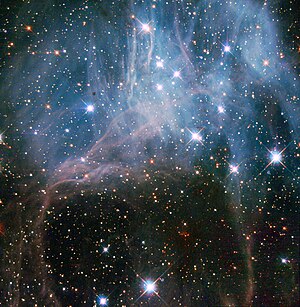
Dorado is a constellation in the Southern Sky. It was named in the late 16th century and is now one of the 88 modern constellations. Its name refers to the mahi-mahi, which is known as dorado ("golden") in Spanish, although it has also been depicted as a swordfish. Dorado contains most of the Large Magellanic Cloud, the remainder being in the constellation Mensa. The South Ecliptic pole also lies within this constellation.
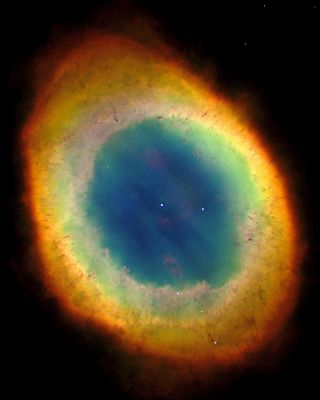
An emission nebula is a nebula formed of ionized gases that emit light of various wavelengths. The most common source of ionization is high-energy ultraviolet photons emitted from a nearby hot star. Among the several different types of emission nebulae are H II regions, in which star formation is taking place and young, massive stars are the source of the ionizing photons; and planetary nebulae, in which a dying star has thrown off its outer layers, with the exposed hot core then ionizing them.

The Eagle Nebula is a young open cluster of stars in the constellation Serpens, discovered by Jean-Philippe de Cheseaux in 1745–46. Both the "Eagle" and the "Star Queen" refer to visual impressions of the dark silhouette near the center of the nebula, an area made famous as the "Pillars of Creation" imaged by the Hubble Space Telescope. The nebula contains several active star-forming gas and dust regions, including the aforementioned Pillars of Creation. The Eagle Nebula lies in the Sagittarius Arm of the Milky Way.

NGC 206 is a bright star cloud in the Andromeda Galaxy, and the brightest star cloud in Andromeda when viewed from Earth.

NGC 1569 is a dwarf irregular galaxy in Camelopardalis. The galaxy is relatively nearby and consequently, the Hubble Space Telescope can easily resolve the stars within the galaxy. The distance to the galaxy was previously believed to be only 2.4 Mpc. However, in 2008 scientists studying images from Hubble calculated the galaxy's distance at nearly 11 million light-years away, about 4 million light-years farther than previously thought, meaning it is a member of the IC 342 group of galaxies.
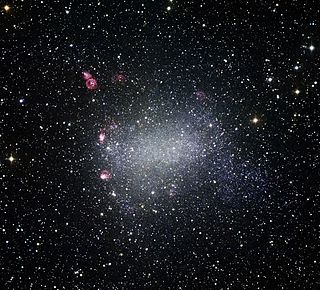
NGC 6822 is a barred irregular galaxy approximately 1.6 million light-years away in the constellation Sagittarius. Part of the Local Group of galaxies, it was discovered by E. E. Barnard in 1884, with a six-inch refractor telescope. It is the closest non-satellite galaxy to the Milky Way, but lies just outside its virial radius. It is similar in structure and composition to the Small Magellanic Cloud. It is about 7,000 light-years in diameter.
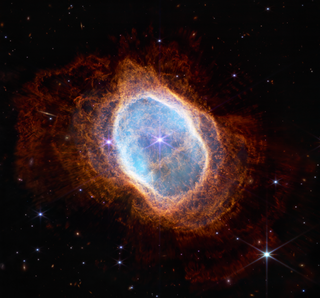
NGC 3132 is a bright and extensively studied planetary nebula in the constellation Vela. Its distance from Earth is estimated at about 613 pc. or 2,000 light-years.
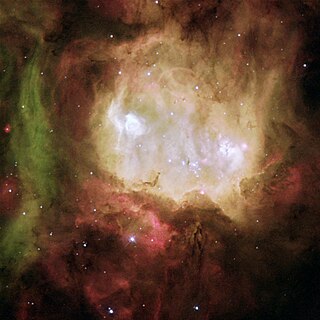
NGC 2080, also known as the Ghost Head Nebula, is a star-forming region and emission nebula to the south of the 30 Doradus (Tarantula) nebula, in the southern constellation Dorado. It belongs to the Large Magellanic Cloud, a satellite galaxy to the Milky Way, which is at a distance of 168,000 light years. NGC 2080 was discovered by John Frederick William Herschel in 1834. The Ghost Head Nebula has a diameter of 50 light-years and is named for the two distinct white patches it possesses, called the "eyes of the ghost". The western patch, called A1, has a bubble in the center which was created by the young, massive star it contains. The eastern patch, called A2, has several young stars in a newly formed cluster, but they are still obscured by their originating dust cloud. Because neither dust cloud has dissipated due to the stellar radiation, astronomers have deduced that both sets of stars formed within the past 10,000 years. These stars together have begun to create a bubble in the nebula with their outpourings of material, called stellar wind.
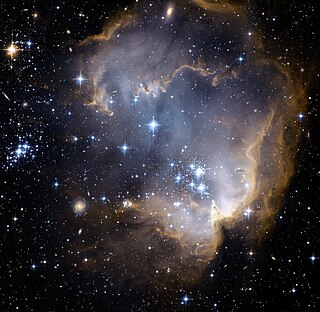
NGC 602 is a young, bright open cluster of stars located in the Small Magellanic Cloud (SMC), a satellite galaxy to the Milky Way. It is embedded in a nebula known as N90.

NGC 7635, also known as the Bubble Nebula, Sharpless 162, or Caldwell 11, is an H II region emission nebula in the constellation Cassiopeia. It lies close to the open cluster Messier 52. The "bubble" is created by the stellar wind from a massive hot, 8.7 magnitude young central star, SAO 20575 (BD+60°2522). The nebula is near a giant molecular cloud which contains the expansion of the bubble nebula while itself being excited by the hot central star, causing it to glow. It was discovered in November 1787 by William Herschel. The star BD+60°2522 is thought to have a mass of about 44 M☉.
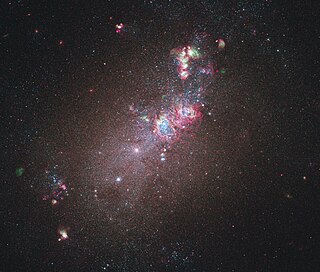
NGC 4214 is a dwarf barred irregular galaxy located around 10 million light-years away in the constellation Canes Venatici. NGC 4214 is a member of the M94 Group.
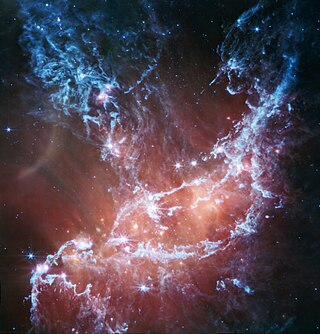
NGC 346 is a young open cluster of stars with associated nebula located in the Small Magellanic Cloud (SMC) that appears in the southern constellation of Tucana. It was discovered August 1, 1826 by Scottish astronomer James Dunlop. J. L. E. Dreyer described it as, "bright, large, very irregular figure, much brighter middle similar to double star, mottled but not resolved". On the outskirts of the cluster is the multiple star system HD 5980, one of the brightest stars in the SMC.

NGC 290 is an open cluster of stars in the southern constellation of Tucana. This cluster was discovered September 5, 1826, by Scottish astronomer James Dunlop. It lies some 200,000 light years away from the Sun in the Small Magellanic Cloud galaxy. The cluster is an estimated 30–63 million years old and is around 65 light years across.

NGC 2261 is a variable nebula located in the constellation Monoceros. The nebula is illuminated by the star R Monocerotis, which is not directly visible itself.

NGC 265 is an open cluster of stars in the southern constellation of Tucana. It is located in the Small Magellanic Cloud, a nearby dwarf galaxy. The cluster was discovered by English astronomer John Herschel on April 11, 1834. J. L. E. Dreyer described it as, "faint, pretty small, round", and added it as the 265th entry in his New General Catalogue.

The Little Gem Nebula or NGC 6818 is a planetary nebula located in the constellation of Sagittarius. It has magnitude 10 and oval diameter of 15 to 22 arcseconds with a 15th magnitude central star.
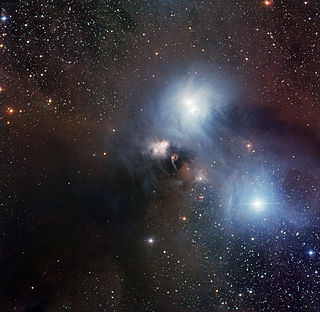
NGC 6729 is a reflection/emission nebula of the Corona Australis Molecular Cloud in the constellation Corona Australis. It was discovered by Johann Friedrich Julius Schmidt in 1861.

NGC 660 is a peculiar and unique polar-ring galaxy located approximately 45 million light-years from Earth in the Pisces constellation. It is the only such galaxy having, as its host, a "late-type lenticular galaxy". It was probably formed when two galaxies collided a billion years ago. However, it may have first started as a disk galaxy that captured matter from a passing galaxy. This material could have, over time, become "strung out" to form a rotating ring.

NGC 2035 is an emission nebula and a H II region in the Dorado constellation and part of the Large Magellanic Cloud. It was discovered by James Dunlop on August 3, 1826. Its apparent size is 3.0.
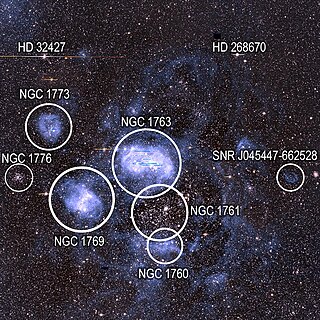
N11 is the brightest emission nebula in the north-west part of the Large Magellanic Cloud in the Dorado constellation. The N11 complex is the second largest H II region of that galaxy, the largest being the Tarantula Nebula. It covers an area approximately 6 arc minutes across. It has an elliptical shape and consists of a large bubble, generally clear interstellar area, surrounded by nine large nebulae. It was named by Karl Henize in 1956.
